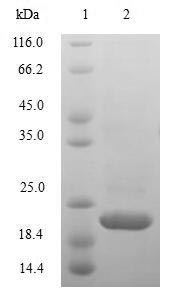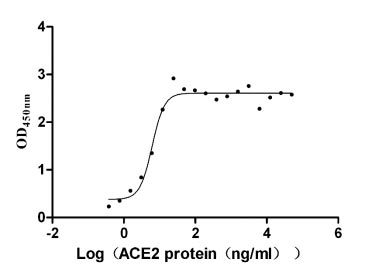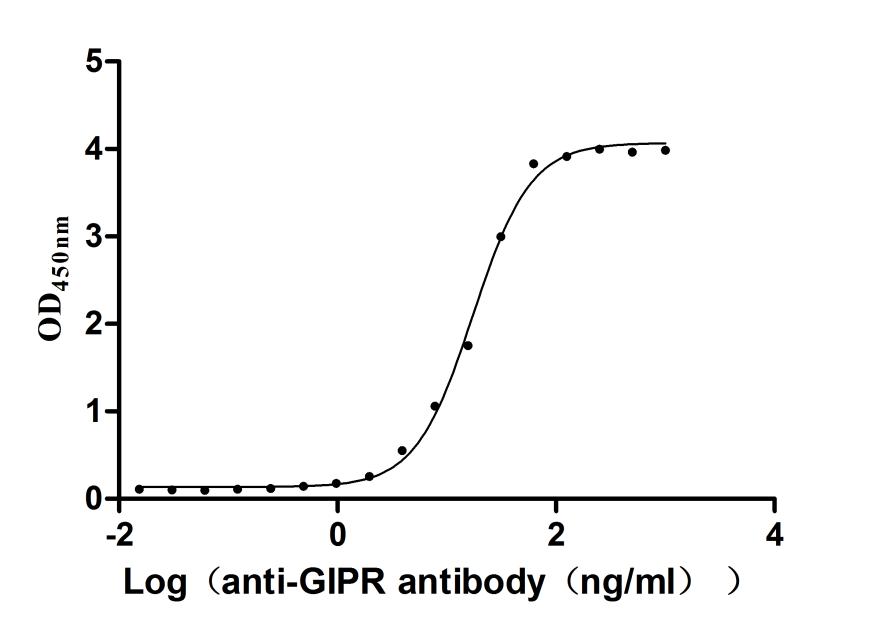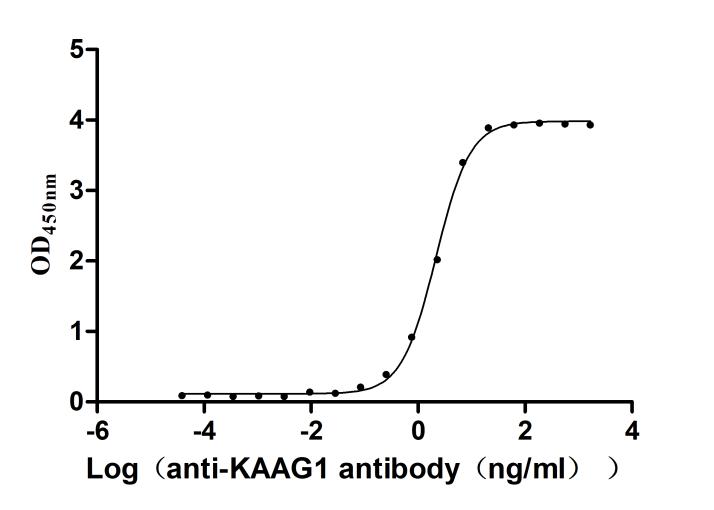Recombinant Macaca mulatta Interleukin-10 (IL10)
In Stock-
中文名稱:獼猴IL10重組蛋白
-
貨號(hào):CSB-MP011580MOW
-
規(guī)格:¥1140
-
圖片:
-
其他:
產(chǎn)品詳情
-
純度:Greater than 85% as determined by SDS-PAGE.
-
基因名:
-
Uniprot No.:
-
別名:IL10Interleukin-10; IL-10; Cytokine synthesis inhibitory factor; CSIF
-
種屬:Macaca mulatta (Rhesus macaque)
-
蛋白長(zhǎng)度:Full Length of Mature Protein
-
來源:Mammalian cell
-
分子量:20.7kDa
-
表達(dá)區(qū)域:19-178aa
-
氨基酸序列SPGQGTQSENSCTRFPGNLPHMLRDLRDAFSRVKTFFQMKDQLDNILLKESLLEDFKGYLGCQALSEMIQFYLEEVMPQAENHDPDIKEHVNSLGENLKTLRLRLRRCHRFLPCENKSKAVEQVKNAFSKLQEKGVYKAMSEFDIFINYIEAYMTMKIQN
Note: The complete sequence may include tag sequence, target protein sequence, linker sequence and extra sequence that is translated with the protein sequence for the purpose(s) of secretion, stability, solubility, etc.
If the exact amino acid sequence of this recombinant protein is critical to your application, please explicitly request the full and complete sequence of this protein before ordering. -
蛋白標(biāo)簽:C-terminal 10xHis-tagged
-
產(chǎn)品提供形式:Liquid or Lyophilized powder
Note: We will preferentially ship the format that we have in stock, however, if you have any special requirement for the format, please remark your requirement when placing the order, we will prepare according to your demand. -
緩沖液:Tris-based buffer,50% glycerol
-
儲(chǔ)存條件:Store at -20°C/-80°C upon receipt, aliquoting is necessary for mutiple use. Avoid repeated freeze-thaw cycles.
-
保質(zhì)期:The shelf life is related to many factors, storage state, buffer ingredients, storage temperature and the stability of the protein itself.
Generally, the shelf life of liquid form is 6 months at -20°C/-80°C. The shelf life of lyophilized form is 12 months at -20°C/-80°C. -
貨期:3-7 business days
-
注意事項(xiàng):Repeated freezing and thawing is not recommended. Store working aliquots at 4°C for up to one week.
-
產(chǎn)品描述:
This Recombinant Macaca mulatta IL10 protein was made through genetic engineering. By putting the IL10 gene into the genetic material of Mammalian cell cell, the Mammalian cell could be used as factories or producers to make the desired IL10 protein for research uses. The expression region of this protein is at 19-178aa. C-terminal 10xHis tag was used in the expression process. The purity is 85%+ determined by SDS-PAGE.
IL-10 is the founding member of a family of cytokines. The involvement of IL-10 in many disease states has been demonstrated, both in animal models and in humans with mutations in the IL-10/IL-10R axis. IL-10 was discovered 30 yr ago as a secreted cytokine synthesis inhibitory factor, produced by T helper (Th) 2 cell clones shown to inhibit cytokine production by Th1 cells. IL10–mediated inhibition of IFN-γ secretion by Th1 cells was demonstrated to occur via its action on the APC function of macrophages and by its inhibition of cytokine production by activated macrophages and dendritic cells. Additionally, IL-10 inhibited the killing of intracellular pathogens. The role of IL-10 clearly exceeds the regulation of intestinal inflammation, as a function for this molecule has been also described in several other settings, from inflammatory or neurodegenerative diseases to infection or cancer. In summary, IL-10 has emerged as a major suppressor of the immune response and a key player in human disease, and is thus an attractive therapeutic target. -
Datasheet & COA:Please contact us to get it.
相關(guān)產(chǎn)品
靶點(diǎn)詳情
-
功能:Major immune regulatory cytokine that acts on many cells of the immune system where it has profound anti-inflammatory functions, limiting excessive tissue disruption caused by inflammation. Mechanistically, IL10 binds to its heterotetrameric receptor comprising IL10RA and IL10RB leading to JAK1 and STAT2-mediated phosphorylation of STAT3. In turn, STAT3 translocates to the nucleus where it drives expression of anti-inflammatory mediators. Targets antigen-presenting cells (APCs) such as macrophages and monocytes and inhibits their release of pro-inflammatory cytokines including granulocyte-macrophage colony-stimulating factor /GM-CSF, granulocyte colony-stimulating factor/G-CSF, IL-1 alpha, IL-1 beta, IL-6, IL-8 and TNF-alpha. Interferes also with antigen presentation by reducing the expression of MHC-class II and co-stimulatory molecules, thereby inhibiting their ability to induce T cell activation. In addition, controls the inflammatory response of macrophages by reprogramming essential metabolic pathways including mTOR signaling.
-
基因功能參考文獻(xiàn):
- IL-10 produced during the immune response to malaria in this model contributes to suppression of mucosal inflammatory responses to invasive NTS, which may contribute to differences in the clinical presentation of NTS infection in the setting of malaria. PMID: 24670425
- Findings demonstrate that internalization of IL-10R with the resultant impact on IL-10 signaling and dysregulation of the IL-10-mediated anti-inflammatory responses might play a crucial role in epithelial cell damage and subsequent simian immunodeficiency virus pathogenesis. PMID: 25165117
- IL-10 plays a crucial role in maintaining mucosal homeostasis by regulating mucosal IFNgamma and TNFalpha cytokine production. PMID: 23867612
-
亞細(xì)胞定位:Secreted.
-
蛋白家族:IL-10 family
-
數(shù)據(jù)庫鏈接:
Most popular with customers
-
Recombinant Paguma larvata Angiotensin-converting enzyme 2 (ACE2), partial (Active)
Express system: Mammalian cell
Species: Paguma larvata (Masked palm civet)
-
Recombinant Dog B-lymphocyte antigen CD20 (MS4A1)-VLPs (Active)
Express system: Mammalian cell
Species: Canis lupus familiaris (Dog) (Canis familiaris)
-
Recombinant Human Gastric inhibitory polypeptide receptor(GIPR),partial (Active)
Express system: Mammalian cell
Species: Homo sapiens (Human)
-
Recombinant Human Kidney-associated antigen 1 (KAAG1) (Active)
Express system: E.coli
Species: Homo sapiens (Human)
-
Recombinant Human Tumor necrosis factor ligand superfamily member 15(TNFSF15) (Active)
Express system: Mammalian cell
Species: Homo sapiens (Human)
-
Recombinant Human Mucin-13(MUC13),partial (Active)
Express system: yeast
Species: Homo sapiens (Human)







-AC1.jpg)










